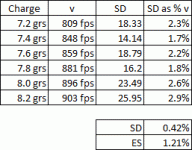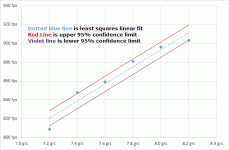Hello everybody. I did a work up for 45 ACP, using the Hornady 230 grain XTP bullet, with HS-6 under. I got out to the range yesterday to chrono them . . .
Gun: Springfield Mil-Spec - near new; full-size; 5" bbl; Wilson Combat 20 Lb recoil spring, with shock buffer.
Chronograph is a Chrony Master Beta - 4 yards out (same as always for me).
CCI 300 primers. Mixed brass - some of it amazingly old, btw.
OAL - 1.240; attained via plunk test. Medium taper crimp.
12 round samples.
Here's the numbers:
7.2gn - 809 f/s; 18.33 SD; soot, unburnt powder.
7.4gn - 848 f/s; 14.14 SD; seemed sooty.
7.6gn - 859 f/s; 18.79 SD; ran fairly clean, and started to feel "right."
7.8gn - 881 f/s; 16.20 SD; ran clean.
8.0gn - 896 f/s; 23.49 SD; ran clean, feels stout.
8.2gn - 903 f/s; 25.95 SD; ran clean, feels stout.
So there it is. My observation: velocities flattened and SD's went up after 7.8 grains - a bit disappointing, as this is where HS-6 is suppose to shine brightest (heavy slugs; loaded up good n stout). I really wish the results on the high end were more linear, as it would make my decision on where to narrow it down a lot easier. Either way, the next step is to try a larger sample. It's just a question of which charge weight.
According to tnoutdoors9's U-tube video (https://www.youtube.com/watch?v=3Ct33tKvpKo) using the factory-loaded version of this bullet (+P); he got 896 f/s from his full-size Colt.
So between the velocity flattening of my results, and his results using known +P pressured ammo; I have chosen not to go any further with the charge weights. Next, I will likely chrono a large sample at 8.0 grains.
All of these shot nice with no feeding/cycling problems. The XTP ogive is rather pointy and seems to lend itself to reliable feeding. They all shot straight.
For those of you playing at home with QuickLOAD, I had to tweek the OAL to 1.300" in order to get near-like results; however, QL gave higher velocities (902, & 922 respectively) with the last two charge weights - as my actual results flattened out.
About propellant selection: I considered Power Pistol; but PP is a bit spunky and makes me nervy doing defense load work ups with heavy bullets. It ignites easily and is highly energetic - and that bodes well for lighter bullets. Which is why my 45 ACP defense loading with 185's is indeed Power Pistol.
I considered AA#7; but AA7 is a bit slow for my taste in this application. I haven't ruled out trying it, but my expectation wouldn't be very high. I'm not sure 45 ACP is a high enough pressure round to get #7 to burn the way it's designed - just my opinion. At any rate, trying it is low in my priority list; and I have plenty of other irons in the fire right now.
I like this 230 XTP bullet. I believe - when loaded properly - it is quite capable of being an effective defense round. And my gun seems to gobble them right up.
Gun: Springfield Mil-Spec - near new; full-size; 5" bbl; Wilson Combat 20 Lb recoil spring, with shock buffer.
Chronograph is a Chrony Master Beta - 4 yards out (same as always for me).
CCI 300 primers. Mixed brass - some of it amazingly old, btw.
OAL - 1.240; attained via plunk test. Medium taper crimp.
12 round samples.
Here's the numbers:
7.2gn - 809 f/s; 18.33 SD; soot, unburnt powder.
7.4gn - 848 f/s; 14.14 SD; seemed sooty.
7.6gn - 859 f/s; 18.79 SD; ran fairly clean, and started to feel "right."
7.8gn - 881 f/s; 16.20 SD; ran clean.
8.0gn - 896 f/s; 23.49 SD; ran clean, feels stout.
8.2gn - 903 f/s; 25.95 SD; ran clean, feels stout.
So there it is. My observation: velocities flattened and SD's went up after 7.8 grains - a bit disappointing, as this is where HS-6 is suppose to shine brightest (heavy slugs; loaded up good n stout). I really wish the results on the high end were more linear, as it would make my decision on where to narrow it down a lot easier. Either way, the next step is to try a larger sample. It's just a question of which charge weight.
According to tnoutdoors9's U-tube video (https://www.youtube.com/watch?v=3Ct33tKvpKo) using the factory-loaded version of this bullet (+P); he got 896 f/s from his full-size Colt.
So between the velocity flattening of my results, and his results using known +P pressured ammo; I have chosen not to go any further with the charge weights. Next, I will likely chrono a large sample at 8.0 grains.
All of these shot nice with no feeding/cycling problems. The XTP ogive is rather pointy and seems to lend itself to reliable feeding. They all shot straight.
For those of you playing at home with QuickLOAD, I had to tweek the OAL to 1.300" in order to get near-like results; however, QL gave higher velocities (902, & 922 respectively) with the last two charge weights - as my actual results flattened out.
About propellant selection: I considered Power Pistol; but PP is a bit spunky and makes me nervy doing defense load work ups with heavy bullets. It ignites easily and is highly energetic - and that bodes well for lighter bullets. Which is why my 45 ACP defense loading with 185's is indeed Power Pistol.
I considered AA#7; but AA7 is a bit slow for my taste in this application. I haven't ruled out trying it, but my expectation wouldn't be very high. I'm not sure 45 ACP is a high enough pressure round to get #7 to burn the way it's designed - just my opinion. At any rate, trying it is low in my priority list; and I have plenty of other irons in the fire right now.
I like this 230 XTP bullet. I believe - when loaded properly - it is quite capable of being an effective defense round. And my gun seems to gobble them right up.


